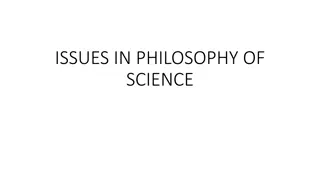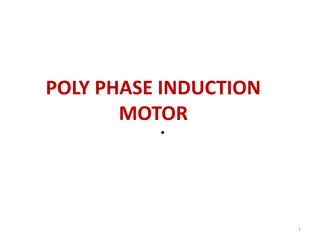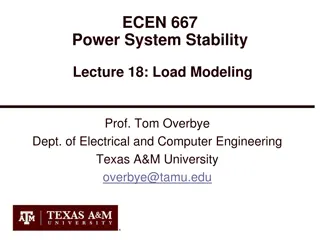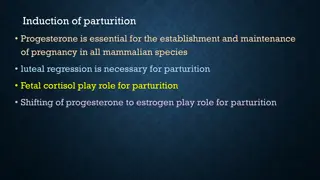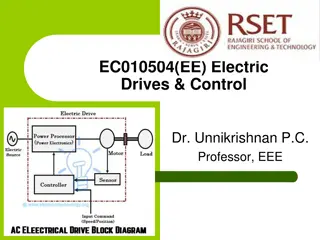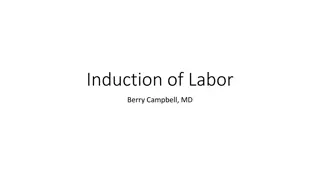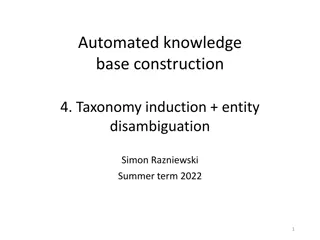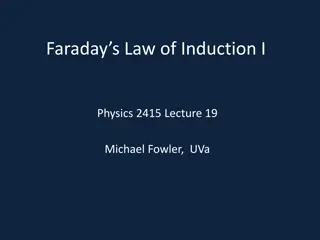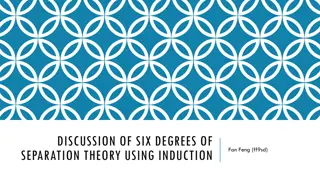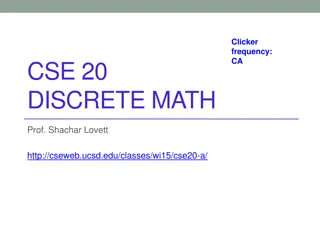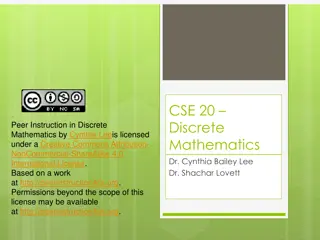
Discrete Mathematics for Computer Science - Strong Induction Examples
Explore strong induction examples in discrete mathematics for computer science, covering topics such as divisibility by a prime, recursion sequence, and product of fractions. Understand the difference between strong and regular induction, with detailed proofs and examples showcasing the power of strong induction in solving mathematical problems efficiently.
Download Presentation

Please find below an Image/Link to download the presentation.
The content on the website is provided AS IS for your information and personal use only. It may not be sold, licensed, or shared on other websites without obtaining consent from the author. If you encounter any issues during the download, it is possible that the publisher has removed the file from their server.
You are allowed to download the files provided on this website for personal or commercial use, subject to the condition that they are used lawfully. All files are the property of their respective owners.
The content on the website is provided AS IS for your information and personal use only. It may not be sold, licensed, or shared on other websites without obtaining consent from the author.
E N D
Presentation Transcript
CSE 20: Discrete Mathematics for Computer Science Prof. Shachar Lovett
2 Today s Topics: 1. Strong vs regular indiction 2. Strong induction examples: Divisibility by a prime Recursion sequence: product of fractions
3 1. Strong induction examples DIVISIBILITY BY A PRIME
4 Strong vs regular induction Prove: n 1 P(n) Base case: P(1) Regular induction: P(n) P(n+1) P(1) P(2) P(3) P(n) P(n+1) Strong induction: (P(1) P(n)) P(n+1) Can use more assumptions to prove P(n+1) P(1) P(2) P(3) P(n) P(n+1)
5 Example for the power of strong induction Theorem: For all prices p >= 8 cents, the price p can be paid using only 5-cent and 3-cent coins Proof: Base case: 8=3+5, 9=3+3+3, 10=5+5 Assume it holds for all prices 8..p-1, prove for price p when p 11 Proof: since p-3 8 we can use the inductive hypothesis for p-3. To get price p simply add another 3-cent coin. Much easier than standard induction!
6 2. Strong induction examples DIVISIBILITY BY A PRIME
7 Definitions and properties for this proof Definitions: n is prime if n is composite if n=ab for some 1<a,b<n = = = , : 1 1 a b N n ab a b Prime or Composite exclusivity: All integers greater than 1 are either prime or composite (exclusive or can t be both). Definition of divisible: n is divisible by d iff n = dk for some integer k. 2 is prime (you may assume this; it also follows from the definition).
8 Definitions and properties for this proof (cont.) Goes without saying at this point: The set of Integers is closed under addition and multiplication Use algebra as needed
9 Thm: For all integers n greater than 1, n is divisible by a prime number. Proof (by strong mathematical induction): Basis step: Show the theorem holds for n = ________. Inductive step: Assume [or Suppose ] that WTS that So the inductive step holds, completing the proof.
10 Thm: For all integers n greater than 1, n is divisible by a prime number. Proof (by strong mathematical induction): Basis step: Show the theorem holds for n = ________. Inductive step: Assume [or Suppose ] that A. 0 B. 1 C. 2 D. 3 E. Other/none/more than one WTS that So the inductive step holds, completing the proof.
11 Thm: For all integers n greater than 1, n is divisible by a prime number. Proof (by strong mathematical induction): Basis step: Show the theorem holds for n = _2______. Inductive step: Assume [or Suppose ] that A. For some integer n>1, n is divisible by a prime number. B. For some integer n>1, k is divisible by a prime number, for all integers k where 2 k n. C. Other/none/more than one WTS that So the inductive step holds, completing the proof.
12 Thm: For all integers n greater than 1, n is divisible by a prime number. Proof (by strong mathematical induction): Basis step: Show the theorem holds for n = _2______. Inductive step: Assume [or Suppose ] that A. n+1 is divisible by a prime number. B. k+1 is divisible by a prime number. C. Other/none/more than one WTS that So the inductive step holds, completing the proof.
13 Thm: For all integers n greater than 1, n is divisible by a prime number. Proof (by strong mathematical induction): Basis step: Show the theorem holds for n=2. Inductive step: Assume that for some n 2, all integers 2 k n are divisible by a prime. WTS that n+1 is divisible by a prime. Proof by cases: Case 1: n+1 is prime. n+1 divides itself so we are done. Case 2: n+1 is composite. Then n+1=ab with 1<a,b<n+1. By the induction hypothesis, since a n there exists a prime p which divides a. So p|a and a|n+1. We ve already seen that this Implies that p|n+1 (in exam give full details!) So the inductive step holds, completing the proof.
14 2. Strong induction examples RECURSION SEQUENCE: PRODUCT OF FRACTIONS
15 Definitions and properties for this proof Product less than one: Algebra, etc., as usual
16 Definition of the sequence: d1 = 9/10 d2 = 10/11 dk = (dk-1)(dk-2) for all integers k 3 Thm: For all integers n>0, 0<dn<1. Proof (by strong mathematical induction): Basis step: Show the theorem holds for n = ________. Inductive step: Assume [or Suppose ] that WTS that So the inductive step holds, completing the proof.
17 Definition of the sequence: d1 = 9/10 d2 = 10/11 dk = (dk-1)(dk-2) for all integers k 3 Thm: For all integers n>0, 0<dn<1. Proof (by strong mathematical induction): Basis step: Show the theorem holds for n = ________. Inductive step: Assume [or Suppose ] that A. 0 B. 1 C. 2 D. 3 E. Other/none/more than one WTS that So the inductive step holds, completing the proof.
18 Definition of the sequence: d1 = 9/10 d2 = 10/11 dk = (dk-1)(dk-2) for all integers k 3 Thm: For all integers n>0, 0<dn<1. Proof (by strong mathematical induction): Basis step: Show the theorem holds for n = _1,2_____. Inductive step: Assume [or Suppose ] that A. For some int n>0, 0<dn<1. B. For some int n>1, 0<dk<1, for all integers k where 1 k n. C. Other/none/more than one WTS that So the inductive step holds, completing the proof.
19 Definition of the sequence: d1 = 9/10 d2 = 10/11 dk = (dk-1)(dk-2) for all integers k 3 Thm: For all integers n>0, 0<dn<1. Proof (by strong mathematical induction): Basis step: Show the theorem holds for n = _1,2_____. Inductive step: Assume [or Suppose ] that A. For some int n>0, 0<dn<1. B. For some int n>1, 0<dk<1, for all integers k where 1 k n. C. 0<dn+1<1 D. Other/none/more than one WTS that So the inductive step holds, completing the proof.
20 Definition of the sequence: d1 = 9/10 d2 = 10/11 dk = (dk-1)(dk-2) for all integers k 3 Thm: For all integers n>0, 0<dn<1. Proof (by strong mathematical induction): Basis step: Show the theorem holds for n=1,2. Inductive step: Assume [or Suppose ] that the theorem holds for n 2. WTS that 0<dn+1<1. By definition, dn+1=dn dn-1. By the inductive hypothesis, 0<dn-1<1 and 0<dn<1. Hence, 0<dn+1<1. So the inductive step holds, completing the proof.
21 3. Fibonacci numbers Verifying a solution
Fibonacci numbers 1,1,2,3,5,8,
Fibonacci numbers 1,1,2,3,5,8,13,21,34,55,
Fibonacci in nature Many more examples: http://jwilson.coe.uga.edu/emat6680/parveen/fib_nature.htm
25 Fibonacci numbers 1,1,2,3,5,8,13,21, Rule: F1=1, F2=1, Fn=Fn-2+Fn-1. Question: can we derive an expression for the n-th term? n n + 1 1 5 1 1 5 YES! = n F 2 2 5 5
26 Fibonacci numbers Rule: F1=1, F2=1, Fn=Fn-2+Fn-1. We will prove an upper bound: + 1 5 = n , n F r r 2 Proof by strong induction. Base case: A. n=1 B. n=2 C. n=1 and n=2 D. n=1 and n=2 and n=3 E. Other
27 Fibonacci numbers Rule: F1=1, F2=1, Fn=Fn-2+Fn-1. We will prove an upper bound: + 1 5 = n , n F r r 2 Proof by strong induction. Base case: A. n=1 B. n=2 C. n=1 and n=2 D. n=1 and n=2 and n=3 E. Other
28 Fibonacci numbers Rule: F1=1, F2=1, Fn=Fn-2+Fn-1. We will prove an upper bound: + 1 5 = n , n F r r 2 Proof by strong induction. Base case: n=1, n=2. Verify by direct calculation = = 2 1 F r 1 F r 1 2
29 Fibonacci numbers Rule: F1=1, F2=1, Fn=Fn-2+Fn-1. + 1 5 Theorem: = n , n F r r 2 Base cases: n=1,n=2 A. Fn=Fn-1+Fn-2 B. Fn Fn-1+Fn-2 C. Fn=rn D. Fn rn E. Other Inductive step: show
30 Fibonacci numbers Rule: F1=1, F2=1, Fn=Fn-2+Fn-1. + 1 5 Theorem: = n , n F r r 2 Base cases: n=1,n=2 A. Fn=Fn-1+Fn-2 B. Fn Fn-1+Fn-2 C. Fn=rn D. Fn rn E. Other Inductive step: show
31 Fibonacci numbers = + n Inductive step: need to show , 1 5 , n F r r 2 What can we use? Definition of Fn: Inductive hypothesis: = + F F F 2 1 n n n 1 2 n n , F r F r 1 2 n n That is, we need to show that r + 2 1 n n n r r
32 Fibonacci numbers Finishing the inductive step. Need to show: + 2 1 n n n r r r 1 r + 2 r Simplifying, need to show: = 1 r + = + 2 Choice of actually satisfied (this is why we chose it!) 1 5 r r 2 QED
33 Fibonacci numbers - recap Recursive definition of a sequence Base case: verify for n=1, n=2 Inductive step: Formulated what needed to be shown as an algebraic inequality, using the definition of Fn and the inductive hypothesis Simplified algebraic inequality Proved the simplified version




